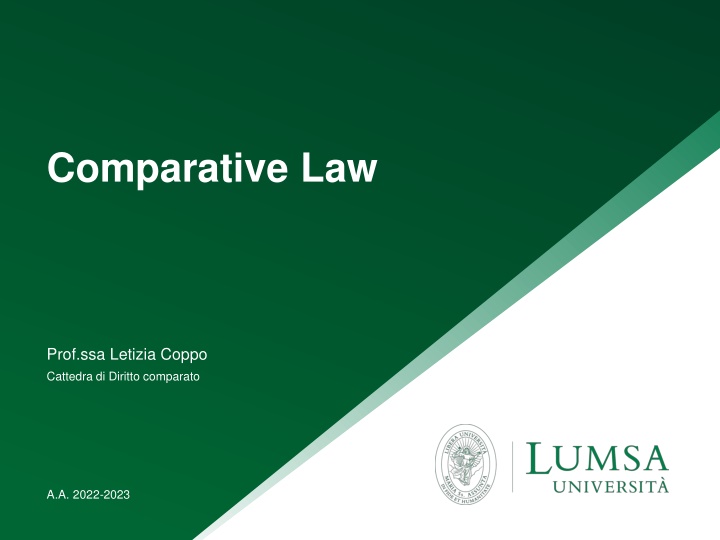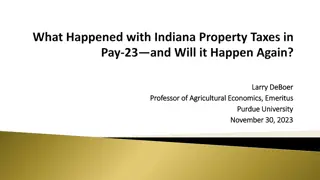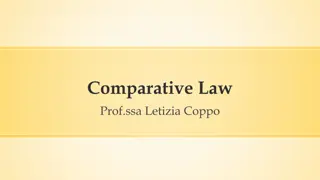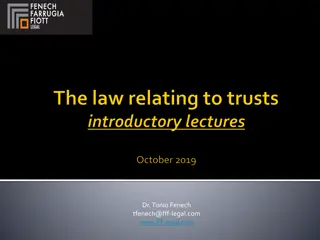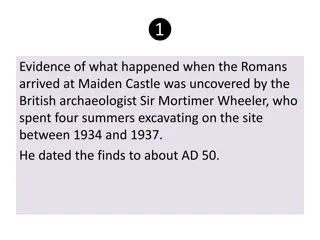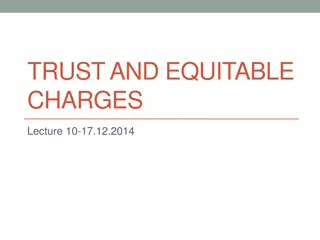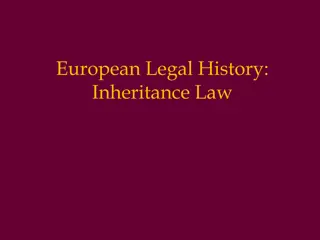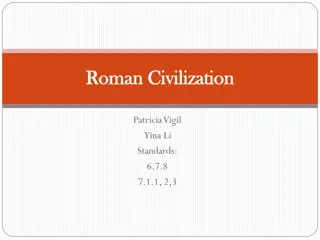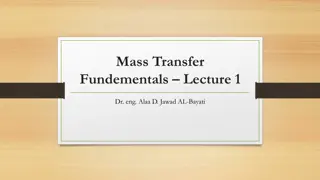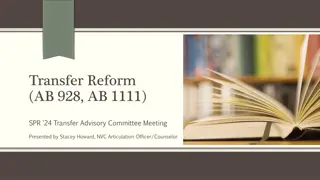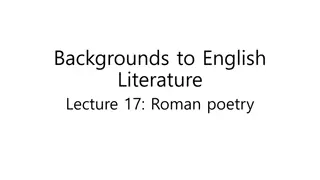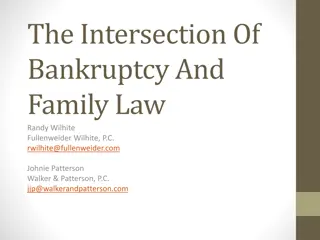Evolution of Property Transfer in Roman Law
Comparative Property Law explores the evolution of property transfer in Roman law. In classical Roman law, property transfer required an external act of delivery. Over time, formal acts like mancipatio and traditio became common for property transfer. During the Justinian period, traditio became the primary method of acquiring property, no longer requiring physical delivery. The contract of sale served as a title, not a mode of acquisition.
Download Presentation

Please find below an Image/Link to download the presentation.
The content on the website is provided AS IS for your information and personal use only. It may not be sold, licensed, or shared on other websites without obtaining consent from the author.If you encounter any issues during the download, it is possible that the publisher has removed the file from their server.
You are allowed to download the files provided on this website for personal or commercial use, subject to the condition that they are used lawfully. All files are the property of their respective owners.
The content on the website is provided AS IS for your information and personal use only. It may not be sold, licensed, or shared on other websites without obtaining consent from the author.
E N D
Presentation Transcript
Comparative Law Prof.ssa Letizia Coppo Cattedra di Diritto comparato A.A. 2022-2023
COMPARATIVE PROPERTY LAW The transfer of property in the Roman law system The principle of translative consent was fully unknown to classical Roman law, where the transfer of property could not take place without an external and separate act of delivery. Emptio venditio (contract of sale) only produced obligatory effects, but those latter did not include the obligation to procure the acquisition of property. The only obligations arising from it were to transfer the mere possession of the goods (vacuum possessionem tradere) and to grant the buyer from eviction. Thus, this contract was just a title (titulus) for the transfer of property, but not a mode of transfer (modus). 3 Universit LUMSA
COMPARATIVE PROPERTY LAW The transfer of property in the Roman law system The translative effect followed from the performance of a formal act (modus), which had a different form depending on the different kind of goods at stake: mancipatio: abstract and formal deed for transferring property on res mancipi; in jure cessio: the same but also applicable to res nec mancipi traditio: causal and informal act for transferring the ex jure Quiritium property of res nec manicipi and praetorian property of res mancipi. 4 Universit LUMSA
COMPARATIVE PROPERTY LAW The transfer of property in the Roman law system The mentioned formal acts just eventually followed the sale contract: as we said, the only obligation of the seller was to transfer the possession of the good, not to perform such acts. So, the buyer could acquire property: either by one of those formal acts, which could transfer property also in the absence of a prior title or when this latter was invalid or, following the title, through the continuous possession of the goods until the expiry date of usucapion, meanwhile relying on the warranty against eviction for the protection of its position. 5 Universit LUMSA
COMPARATIVE PROPERTY LAW The transfer of property in the Roman law system The Justinian period Gradually the traditio became the general way of acquiring property and it was spiritualised (traditio ficta), i.e. the physical delivery of the good was not necessary anymore for the transfer of property. The Corpus Juris codified the principle that the contract of sale is a simple title or cause for the acquisition of property but not the mode of acquisition. 6 Universit LUMSA
COMPARATIVE PROPERTY LAW The transfer of property under intermediate law Intermediate law maintained the principle of the insufficiency of the title and the separation between title and modus. It analysed more in depth the relationship between the two and held that the title (i.e. the contract of sale or donation or exchange) creates and obligation to perform the modus. 7 Universit LUMSA
COMPARATIVE PROPERTY LAW The transfer of property: the French model In the period of jusnaturalism, France had developed a real estate practice according to which the physical delivery of the goods was not necessary anymore for the transfer of property and was replaced with clauses providing that the contract entailed the transfer of possession from the seller to the buyer. The jusnaturalists, with their dogma of will, theorised this by claiming that the mere expression of will contained in the agreement was enough to transfer property. This marks the birth of the consensualistic principle. 8 Universit LUMSA
COMPARATIVE PROPERTY LAW The transfer of property: the French model Jusnaturalism has influenced the Napoleon Code, which codified the principle according to which the titulus is also the modus for the (consensualistic principle), ambiguous formula (replaced with a clearer one after the 2016 reform). transfer though of property rather with a This marks a divergence from Roman law. The Napoleonic model was followed in Italy, Belgium, Luxemburg, Portugal and Poland. 9 Universit LUMSA
COMPARATIVE PROPERTY LAW The transfer of property in the Germanic systems The Germanic systems confirmed the Roman principle for which the title alone is not enough to transfer property and, therefore, the principle of the necessary separation between titulus and modus (principe de s paration; Trennungsgrundsatz). The perpetuation of the Roman tradition did not depend upon the faithfulness to Roman law or upon the ignorance of the consensualistic principle adopted by the Napoleonic code, but was justified by operational reasons. Scholarship believed that the consensualistic principle was incapable of adequately protecting the circulation of goods. 10 Universit LUMSA
COMPARATIVE PROPERTY LAW The transfer of property in the Germanic systems The Prussian Code already distinguished between the consensual contract that entitled the buyer to acquire property (Recht zur Sache) and the real act of alienation, which was the only way to perform the translative obligation. The act of alienation was causal. 11 Universit LUMSA
COMPARATIVE PROPERTY LAW The transfer of property: the Austrian model The Austrian code (ABGB) of 1811 also adopted the Roman solution: the consensual contract (Verpflichtungsgesch ft) creates the obligation to give the goods, i.e. to transfer property, while the performance of such obligation consists of an act which has its cause in the title (Verf gungsgesch ft). Such act of performance is a material act: for movables it is delivery; for immovables is the inscription in the register. The act of performance (modus), though, is a real, negotial, causal and solutory act like the Roman traditio. The Austrian model has been adopted by the Swiss, Dutch and Spanish models. 12 Universit LUMSA
COMPARATIVE PROPERTY LAW The transfer of property: the German model The German civil code (BGB) refused both the Austrian model (i.e. the combination between a title and a causal modus) and the French model (i.e. the consensualistic principle). Instead, it upheld the principle according to which the modus is enough for the transfer of property (the equal and opposite solution compared to the French one). Translated into legal words, this means that the modus is abstract (Abstraktionsprinzip), the modus (Verfugungsgesch ft) is an effective tool for transferring property even in the absence of a prior title or when the prior title exists but is invalid. The Verfugungsgesch ft is similar to the Roman mancipatio: a real and abstract act of will (negozio giuridico) provided with translative effects. 13 Universit LUMSA
COMPARATIVE PROPERTY LAW The transfer of property: the German model Beware: the modus is abstract towards third parties but not towards the parties which formed the title. If the title does not exist or is invalid, the buyer has acquired property (because the modus is enough) but will bear a restitutionary obligation, i.e. the buyer cannot retain property but must return it to the seller. So, if the existence or validity of the title is not necessary to acquire property, it is nevertheless necessary to retain it. If the buyer has already sold the goods to a third party, though, this latter will be entitled to retain the property by virtue of the principle of abstraction. The buyer s obligation to give the property back to the seller will be converted into a monetary obligation: he will have to pay the value of the property. 14 Universit LUMSA
COMPARATIVE PROPERTY LAW The transfer of property: the German model Further remarks: mitigations of the abstraction principle In the sales of movables normally the separation of titulus and modus is not apparent, as the two acts are performed in the same time (agreement and delivery of the goods). In case the seller was not the owner of the goods, there is a provision in the BGB protecting the right of property of third parties having acquired property from the buyer in good faith. In the sales of immovables it is the notary who drafts the modus and he must ascertain the existence of the title, but this only to ascertain that the seller was the owner (thus to avoid restitutionary obligations). Such ascertainment is not extended to the validity of the title. 15 Universit LUMSA
COMPARATIVE PROPERTY LAW Property in common law: the English model The English real property or property in land comes from the Medieval Norman feudal model. The pillar is the principle according to which the land (and all that is attached to it) belongs to the king exclusively and absolutely (ownership). Consequently, the rights of enjoyment of individuals on the land are just the product of a royal grant (tenure). Free tenure or freehold: it was the tenure granted by the king to a nobleman Unfree tenure: it was the tenure granted by a landlord to a vassal who was under a condition of servitude. It was the case for peasants, who were obliged to cultivate the lands belonging to the lord of the manor and could receive from him in exchange a piece of land for their own profit. 16 Universit LUMSA
COMPARATIVE PROPERTY LAW Property in common law: the English model The fundamental element of the tenure was and is the duration and the content of the faculties and rights of enjoyment granted to the tenant. Such duration, which could vary but is normally indefinite, is named estate. Also nowadays the regime of real estate revolves around a plurality of estates with different contents and durations and on the conception that the possession of goods does not imply absolute legal rights, but rather relative legal situations. 17 Universit LUMSA
COMPARATIVE PROPERTY LAW The transfer of property in the English model Movables (chattels) and immovables (real estates) follow different regimes: the transfer of property on movables follows, at least from an applicative viewpoint, the consensualistic model; the transfer of property on immovables, at least at law, consists of two steps: the conclusion of a contract of sale (or other), which obliges to a further translative act; and the conclusion of a deed (i.e. solemn act) called conveyance in favour of the buyer. 18 Universit LUMSA
COMPARATIVE PROPERTY LAW The transfer of property in the English model It may seem that the English regime for the transfer of immovables follows the separation titulus and modus. What needs to be ascertained is whether this is only apparent because the modus is abstract like in the German model) or if it is real because the modus is causal like in the Austrian model. But, before, we should add that, following the Land registration act of 1925, a third step is required for immovables, i.e. the registration of the deed. It is a constitutive publicity. 19 Universit LUMSA
COMPARATIVE PROPERTY LAW The transfer of property in the English model At law, they apply the merger doctrine: the contract of sale only creates the the obligation to transfer property through an act of conveyance; it is after this deed and its registration that the real estate is transferred and the buyer becomes the owner (owner at law). At equity, they apply the doctrine of conversion: the title does not yet transfer property (the real estate) to the buyer but it transfers an equitable interest to him. Thus, he becomes owner at equity and he can benefit from a certain protection of his position. 20 Universit LUMSA
COMPARATIVE PROPERTY LAW The transfer of property in the English model Such separation between equitable property and legal property results in a constructive trust: the seller who has concluded the sale but has not yet concluded the deed and therefore still detains the legal title is considered to be a trustee to the benefit of the buyer, who, in this moment, has an equitable interest. 21 Universit LUMSA
COMPARATIVE PROPERTY LAW The concept of property in the socialist model As a matter of principle, means of production must belong to the State (socialist State ownership). Their management is committed to State enterprises personality and established for that specific purpose. provided with legal The main exception are agricultural means, the permanent and free use of which has been granted to cooperatives of peasants (socialist cooperative ownership). 22 Universit LUMSA
COMPARATIVE PROPERTY LAW The concept of property in the socialist model The individual property of the peasants. goods produced by socialist cooperatives were Houses could be the object of individual property, but the widespread trend was that even the house was State property and the inhabitants were just tenants. Multi-families tenancies were also encouraged as it was a widespread belief that individual families segregate persons from the rest of society. 23 Universit LUMSA
Prof.ssa Letizia Coppo Email: l.coppo1@lumsa.it lcoppo@univ-catholyon.fr
